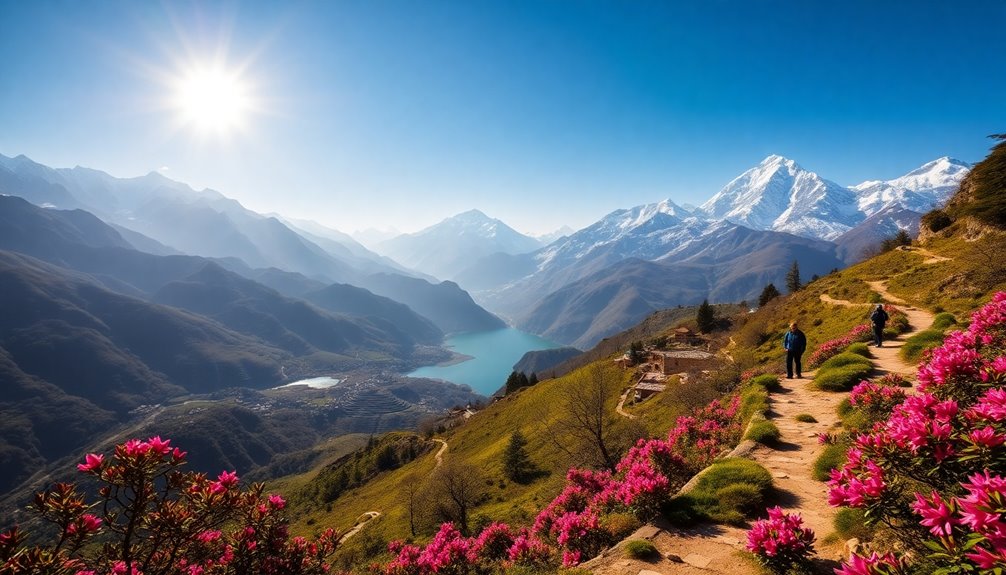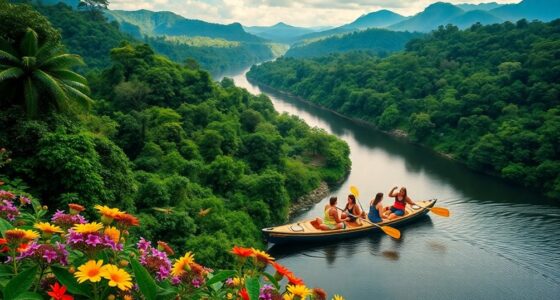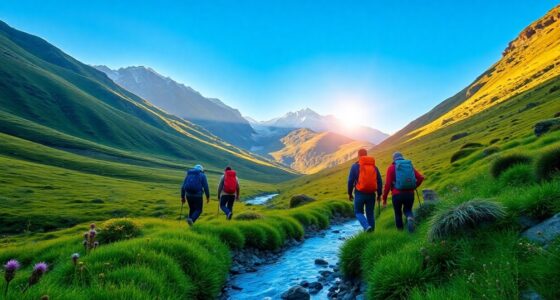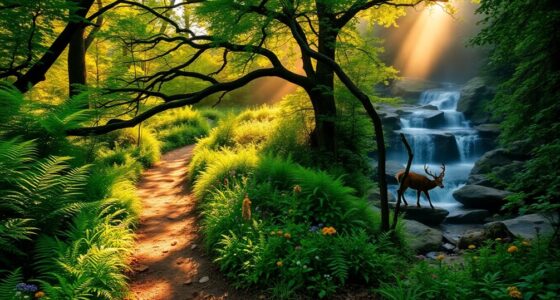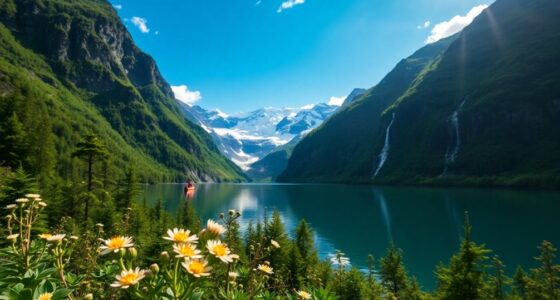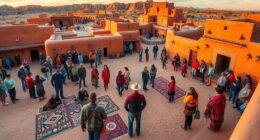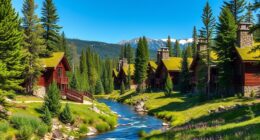Nepal's sustainable treks let you immerse yourself in the breathtaking Himalayas while promoting eco-friendly practices. You'll trek through diverse ecosystems, from subtropical forests to high-altitude deserts, benefiting from controlled paths and eco-friendly lodges that use solar power. Engaging with local communities, you support conservation efforts and experience the rich culture firsthand. The best times to trek are spring and autumn when conditions are optimal. By choosing sustainable travel habits, you reduce your ecological footprint and contribute to wildlife protection programs. There's much more to uncover about these eco-conscious adventures that'll enhance your journey.
Key Takeaways
- Trekking in Nepal supports biodiversity conservation through eco-friendly accommodations and community-led conservation projects that protect endangered species and habitats.
- Controlled trekking paths and permits ensure minimal environmental impact while allowing trekkers to enjoy the stunning Himalayan landscapes.
- Eco-conscious travel options, like electric rickshaws in Kathmandu, help reduce carbon emissions and promote local businesses.
- Optimal trekking seasons in spring and autumn provide clear skies and pleasant temperatures, enhancing the trekking experience while minimizing ecological risks.
- Engaging in community-based homestays and tree planting initiatives fosters cultural exchange and strengthens local economies, promoting sustainable tourism.
Introduction
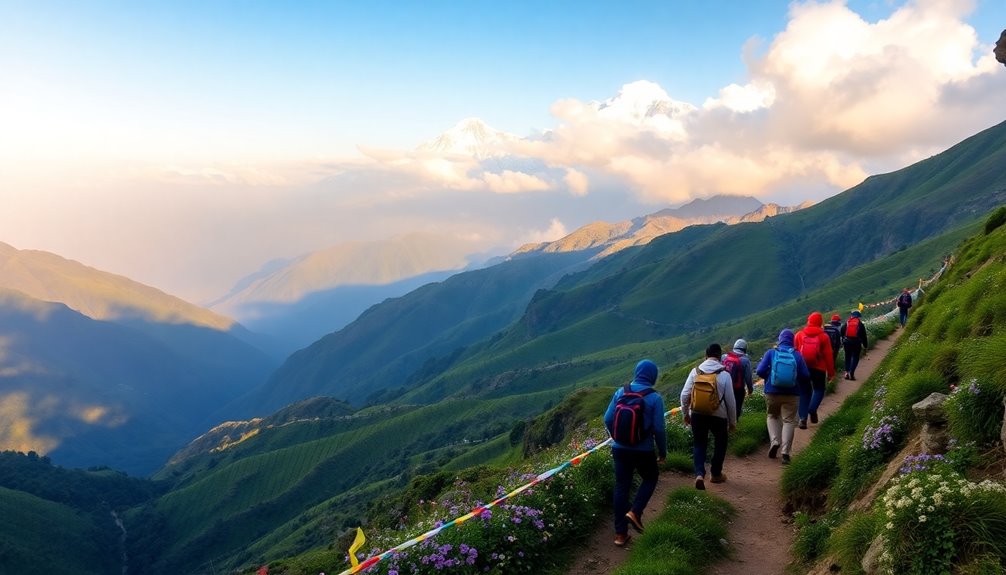
When you explore the breathtaking landscapes of Nepal, you're not just enjoying stunning views; you're also stepping into a treasure trove of Himalayan biodiversity.
This region is home to unique ecosystems that need our care and attention.
Himalayan Biodiversity and Landscapes
The breathtaking landscapes of the Himalayas not only captivate you with their beauty but also harbor an astonishing array of biodiversity. This region boasts over 10,000 species of flowering plants, including unique flora like rhododendrons, thriving in its diverse ecosystems.
You'll encounter around 300 species of mammals, including the endangered snow leopard and the elusive red panda, showcasing Himalayan biodiversity at its finest. The stunning landscapes transition from lush subtropical forests to alpine meadows and high-altitude deserts, each supporting distinct ecosystems.
Notably, Sagarmatha National Park, a UNESCO World Heritage Site, highlights these natural wonders. By embracing eco-friendly practices, you can help preserve this incredible environment while enjoying the majestic beauty of the Himalayas.
Conservation of Unique Ecosystems
While trekking through Nepal's stunning landscapes, you'll discover that conserving unique ecosystems is essential for preserving the region's rich biodiversity.
Sustainable practices are vital in minimizing environmental impact and ensuring the longevity of local ecosystems. Here are some key elements of conservation efforts you'll encounter:
- Controlled trekking paths and waste management to protect habitats
- Eco-friendly accommodations that utilize solar power and sustainable materials
- Community engagement in conservation projects, benefiting both locals and nature
- Educational programs that enhance awareness of local ecosystems and responsible travel
Additionally, many of these initiatives align with the principles of Law of Attraction, promoting a positive mindset towards environmental stewardship.
Travel From Kathmandu to Trails
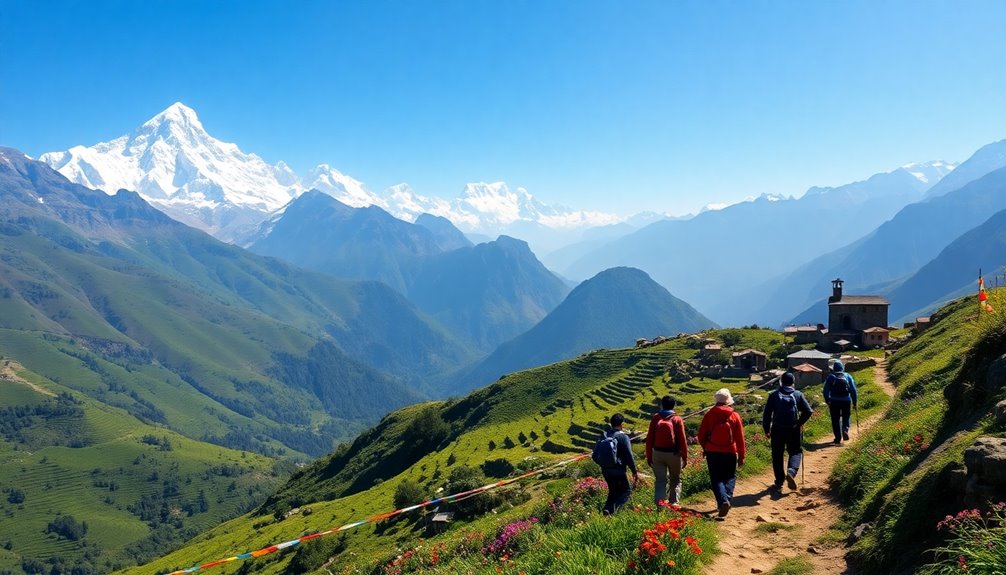
Getting to Kathmandu is your first step toward incredible trekking adventures in Nepal.
Whether you're flying from the USA, London, or Sydney, you'll soon find yourself surrounded by the stunning landscapes of the Himalayas.
Once in Kathmandu, electric rickshaws offer a fun and eco-friendly way to navigate the city as you prepare for your trek.
Fly From USA to Kathmandu
How do you reach the breathtaking trekking trails of Nepal? First, you'll fly from the USA to Kathmandu, typically landing at Tribhuvan International Airport after 18-25 hours.
Once in Kathmandu, you can easily access your trekking starting points through:
- Domestic flights to Lukla or Pokhara
- Ground transportation via private vehicles or local buses
- Obtaining trekking permits like the RAP and national park entry
- Scenic views of the Himalayas along the way
These options ensure a smooth travel experience while promoting eco-friendly practices and sustainable tourism. Additionally, selecting the right projector type can enhance the overall experience of planning your trekking journey by allowing you to visualize your routes and destinations.
Remember, securing your trekking permits is crucial before setting off on your adventure.
With these preparations, you're all set for an unforgettable journey through the stunning landscapes of Nepal.
Travel From London to Kathmandu
Flying from London to Kathmandu is a straightforward journey, with several airlines offering direct flights that make accessing Nepal's trekking trails convenient.
Once you land, you can choose from various local transportation options, like private vehicles or domestic flights, to kickstart your eco-conscious journey.
The trip from Kathmandu to popular trekking locations such as Everest Base Camp or Annapurna Base Camp often involves scenic drives that reveal stunning Himalayan landscapes.
Before you head out, don't forget to secure essential permits for trekking in Kathmandu, ensuring compliance with local regulations and promoting responsible tourism practices.
The travel time varies, with brief flights to Lukla taking about 30-40 minutes and road journeys to Pokhara lasting around 6-8 hours.
Fly From Sydney to Kathmandu
Traveling from Sydney to Kathmandu is an adventure that typically takes about 15 to 20 hours, including layovers.
Once you arrive, the Kathmandu Valley is your gateway to some of the most stunning trekking routes in Nepal. You can fly from Sydney to Kathmandu and then easily access popular trails through various local transportation options.
- Domestic flights to Lukla for the Everest Base Camp Trek
- Tourist buses to trailheads for Annapurna Base Camp
- Shared taxis for budget-friendly travel
- Microbuses for convenient access
Embrace eco-friendly practices as you prepare for your treks. Additionally, consider utilizing smartphone merchant services to facilitate on-the-go transactions for any gear rentals or guided tours during your trip.
With essential services like gear rental and guided tours available in the valley, you're all set for an unforgettable adventure in the Himalayas!
Electric Rickshaws for Local Transport
While exploring Kathmandu, you'll find that electric rickshaws offer a convenient and eco-friendly way to reach the trekking trails. These vehicles significantly reduce carbon emissions, promoting cleaner air quality while you travel. By choosing electric rickshaws, you not only minimize your environmental impact but also support local businesses, as many drivers are community members benefiting from tourism. This aligns perfectly with Nepal's commitment to sustainable tourism and showcases a growing reliance on renewable energy. Additionally, the use of electric rickshaws contributes to lower environmental footprints, which is essential for preserving the natural beauty of the Himalayas.
| Benefit | Impact on Environment | Support for Locals |
|---|---|---|
| Reduced carbon emissions | Cleaner air quality | Economic opportunities |
| Eco-friendly transport | Preserving natural landscapes | Promoting local culture |
| Sustainable tourism | Lower environmental footprint | Strengthening community ties |
Sustainable Wildlife Conservation Programs
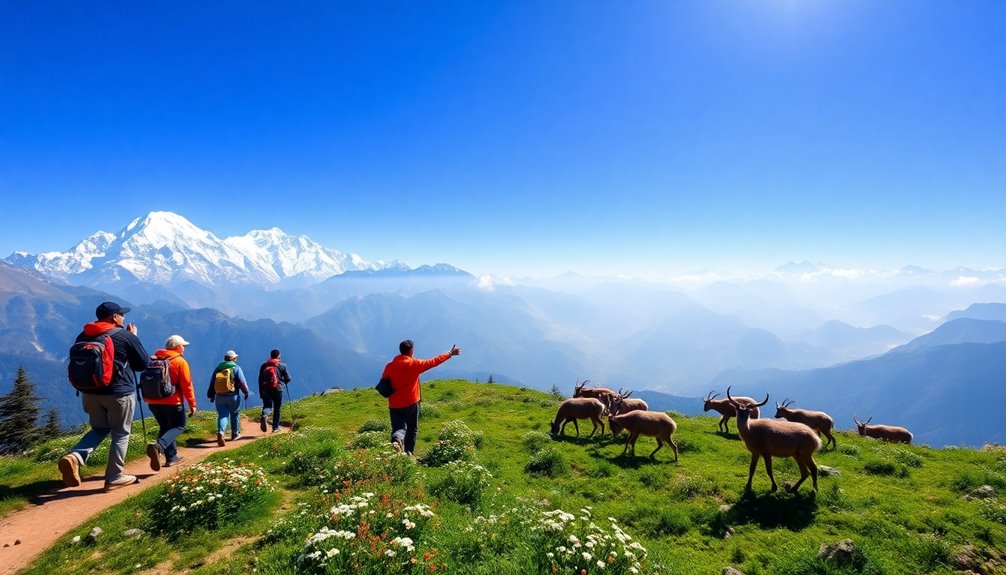
When you explore Nepal, you'll discover sustainable wildlife conservation programs that focus on habitat restoration for endangered species like the Bengal tiger and one-horned rhinoceros.
These efforts not only protect wildlife but also promote sustainable lodging options that complement your trekking experience.
Wildlife Habitat Restoration Projects
Wildlife habitat restoration projects in Nepal play a vital role in conserving the country's rich biodiversity. These initiatives focus on reforestation and ecosystem rehabilitation, especially in areas like the Annapurna Conservation Area.
By engaging local communities, these programs foster environmental stewardship and sustainable practices.
Here are some key aspects of these projects:
- Community-based conservation efforts protect endangered species such as the snow leopard and red panda.
- Trekking tourism revenues support habitat restoration activities and wildlife protection initiatives.
- Local communities receive training and resources for effective habitat restoration.
- Successful projects have led to increased wildlife populations and improved ecosystem health.
Through these collaborative efforts, Nepal's wildlife thrives, ensuring a sustainable future for both nature and local populations.
Wildlife Habitat Restoration Efforts
Building on the success of wildlife habitat restoration projects, sustainable wildlife conservation programs in Nepal emphasize the importance of restoring habitats to enhance ecological balance and support biodiversity.
These initiatives focus on establishing wildlife corridors that connect fragmented areas, allowing endangered species like the Bengal tiger and one-horned rhinoceros to migrate safely, promoting genetic diversity.
Community engagement is crucial; local residents participate in conservation initiatives, helping reduce poaching threats while benefiting economically from eco-tourism. Revenue generated from these activities funds habitat restoration and environmental preservation efforts.
Educational programs raise awareness about sustainable practices and the significance of wildlife protection, encouraging responsible tourism and fostering a collective commitment to preserving Nepal's rich natural heritage.
Sustainable Lodging Options Available
As you explore the breathtaking landscapes of Nepal, you'll find a range of sustainable lodging options that not only enhance your experience but also contribute to wildlife conservation efforts.
Consider these eco-friendly choices:
- Eco-friendly lodges using renewable energy sources like solar power.
- Community-based homestays that support local economies and wildlife conservation initiatives.
- Accommodations implementing waste management protocols to promote responsible tourism.
- Lodges directing profits towards biodiversity protection programs.
Support Local Eco-Friendly Businesses
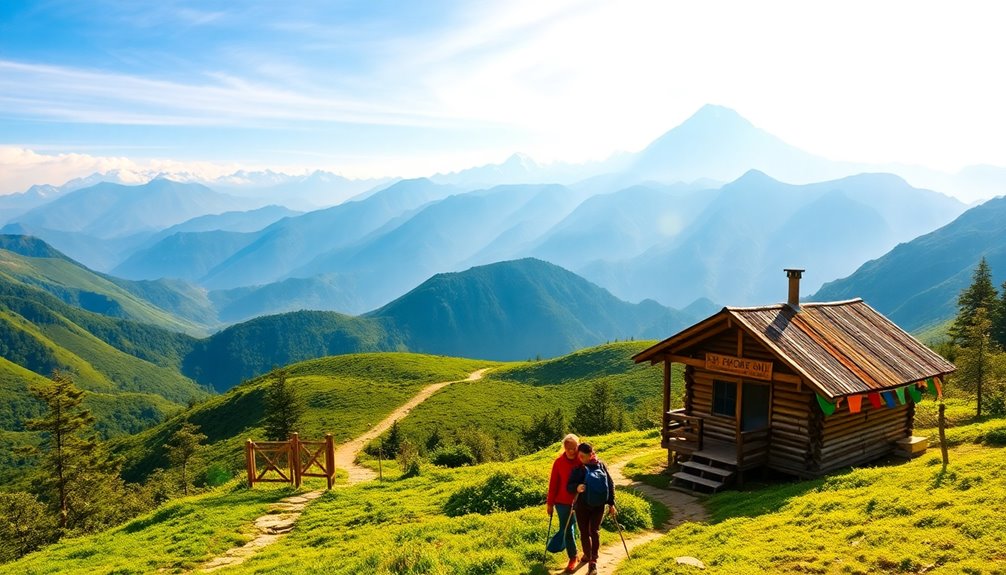
Supporting local eco-friendly businesses in Nepal not only benefits the environment but also enriches your trekking experience. By choosing to support local, you contribute to conservation projects and community development initiatives that prioritize sustainable practices.
Many eco-friendly businesses focus on environmentally responsible methods, from waste management to renewable energy, ensuring your trek has a minimal ecological footprint. Staying in eco-lodges and purchasing goods from local artisans strengthens the local economy while providing you with unique cultural insights.
Moreover, when trekking fees fund community-led projects, you're directly participating in habitat restoration efforts. Embracing these eco-friendly options allows you to explore Nepal's stunning landscapes while positively impacting the communities that welcome you.
Your choices matter; make them count!
Community-led Tree Planting Projects
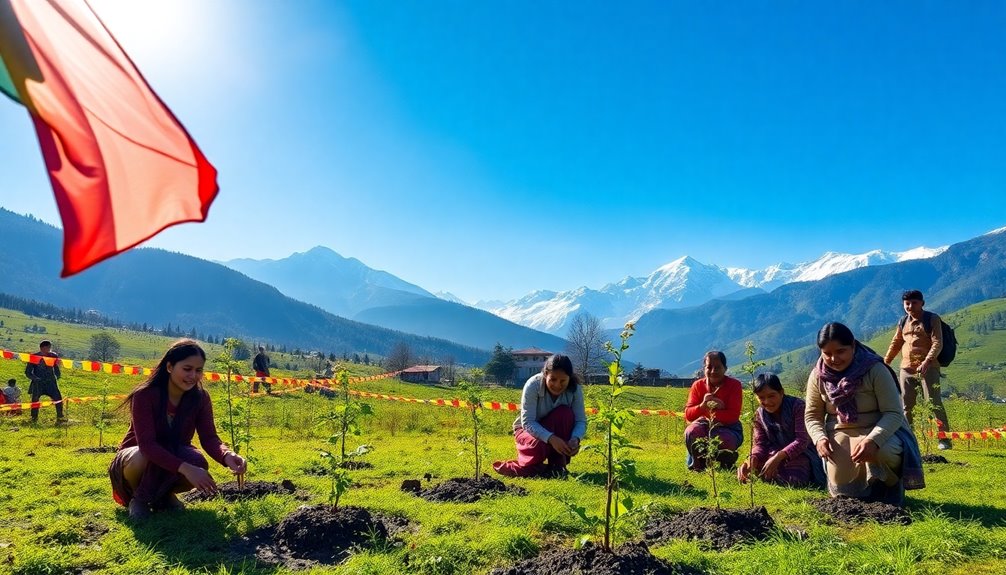
When you participate in community-led tree planting projects in Nepal, you're not just helping the environment; you're also strengthening local ties and cultural sustainability.
These initiatives, supported by government and NGOs, create a sense of shared responsibility among community members.
Government and NGO Efforts
Community-led tree planting projects in Nepal thrive thanks to the collaboration between government initiatives and NGOs, which focus on combating deforestation and enhancing biodiversity in the Himalayan region.
These efforts involve local communities, fostering ownership and responsibility for their environment.
Here are some key aspects of these initiatives:
- Over 2 million trees have been planted through community projects.
- Local communities benefit economically from sustainable forestry practices.
- Educational programs raise awareness about forest conservation and climate change.
- Partnerships with organizations like the Nepalese Ministry of Forests promote effective reforestation.
Community and Cultural Sustainability
While engaging in tree planting projects, you'll discover how these initiatives foster not just environmental restoration but also cultural sustainability within Nepal's diverse communities.
Community-led tree planting projects empower local communities, enhancing biodiversity and promoting sustainable land use practices. By collaborating with NGOs and government bodies, these efforts align with national reforestation goals.
Educational programs accompany the projects, teaching community members about the crucial role of trees in maintaining ecological balance. As you participate, you'll witness the positive impacts—improved soil health, reduced erosion, and increased wildlife habitats.
Each tree planted contributes to a healthier ecosystem, ensuring that both the environment and local cultures thrive for future generations. Embrace this journey and be part of something larger!
Spring and Autumn Trekking Seasons
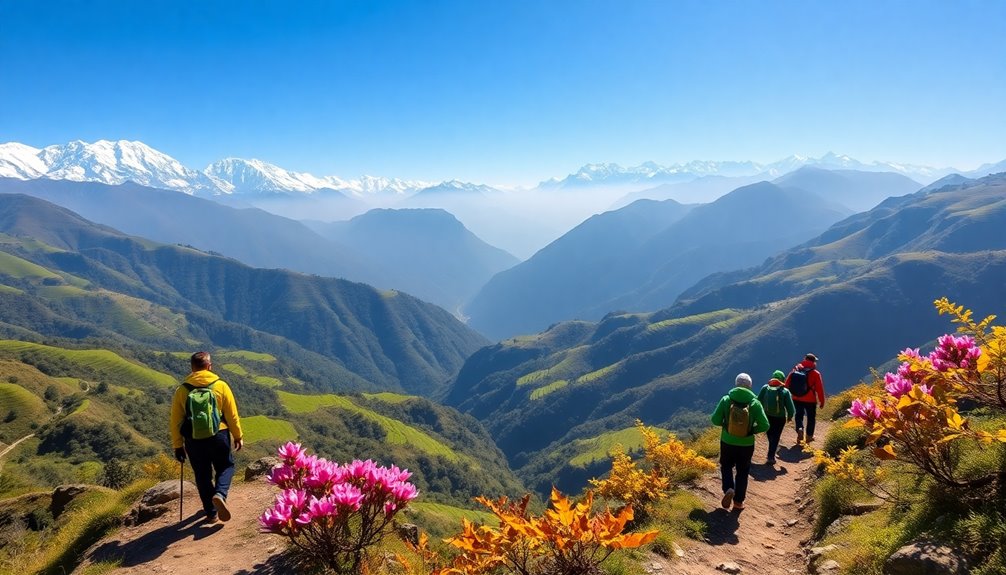
When you're planning your trek in Nepal, spring and autumn are the best seasons to consider.
These periods offer optimal weather, with spring showcasing vibrant blooms and autumn providing clear skies perfect for those stunning Himalayan views.
However, keep in mind the monsoon season's impact on trekking conditions if you're thinking about other times of the year.
Optimal Trekking Weather Periods
Trekking in Nepal is best during the spring and autumn seasons, as these periods offer the most favorable weather conditions for adventurers.
The optimal trekking weather periods ensure you enjoy breathtaking views and comfortable temperatures.
- Spring Season: Experience vibrant natural beauty with blooming rhododendrons and temperatures between 10°C to 20°C (50°F to 68°F).
- Autumn Season: Stable weather brings dry conditions and daytime temperatures averaging 15°C to 25°C (59°F to 77°F).
- Clear Skies: Both seasons provide excellent visibility of Nepal's iconic peaks.
- Enhanced Trekking Experience: Fewer chances of rain improve your overall adventure.
Choosing these seasons guarantees unforgettable memories as you explore the stunning Himalayas!
Monsoon Impacts Trekking Conditions
The monsoon season, which runs from June to September, significantly impacts trekking conditions in Nepal, posing challenges even during the favored spring and autumn months.
Heavy rainfall during this period creates slippery trails and increases the risk of landslides, making treks more hazardous.
While spring (March to May) and autumn (September to November) offer optimal visibility of the Himalayan peaks and stable weather conditions, it's essential to remain vigilant about changing weather.
Trekking during the monsoon may require you to take additional precautions, like ensuring you have proper gear and being ready for sudden shifts in weather.
How to Make Your Trip More Sustainable
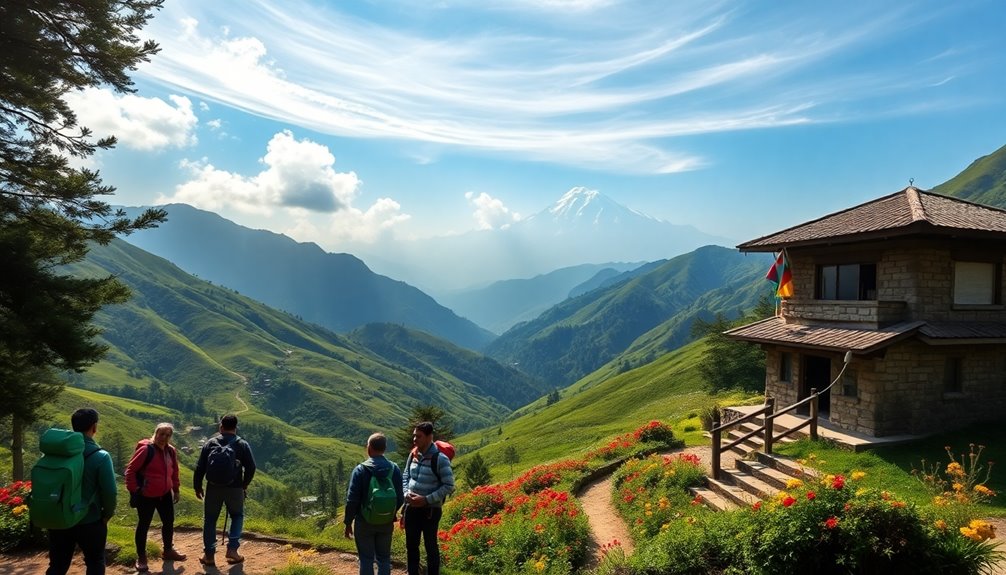
To make your trip more sustainable, consider using biodegradable toiletries and supplies that won't harm the environment.
Engaging a local guide not only enriches your experience but also supports the community and ensures you're following best practices for the region.
Biodegradable Toiletries and Supplies
Choosing biodegradable toiletries and supplies can significantly enhance the sustainability of your trekking adventure in Nepal. By opting for these eco-friendly products, you help minimize pollution in the pristine Himalayan environment.
Here are some tips to make your trip more sustainable:
- Use biodegradable soap, shampoo, and toothpaste that break down naturally.
- Bring biodegradable wipes and toilet paper to reduce waste.
- Support local communities by sourcing biodegradable toiletries from local artisans, boosting the local economy.
- Pack your toiletries in reusable containers to cut down on single-use plastics.
In addition, consider using essential oils for toothache relief as a natural remedy for any discomfort during your trek, promoting both health and sustainability.
Adopting these sustainable travel habits not only reduces your ecological footprint but also contributes to a cleaner environment for everyone.
Enjoy your trek while caring for the planet!
Local Guide Engagement
Engaging a local guide can transform your trekking experience while making it more sustainable. Local guides not only enrich your journey with cultural insights but also ensure your trip supports the local economy. Your fees contribute to community projects and job creation.
They're often well-versed in sustainable practices, helping you follow eco-friendly principles like Leave No Trace. By sourcing food and supplies from local markets, your trek minimizes environmental impact and bolsters economic support for the community.
Plus, trekking with local guides allows for personalized itineraries that reflect your interests while respecting local traditions. You'll also have the chance to participate in conservation initiatives, directly contributing to the protection of ecosystems and cultural heritage in these stunning regions. Engaging in these initiatives can enhance your emotional well-being, as studies show a significant reduction in stress levels among users of aromatherapy.
Frequently Asked Questions
Why Did Nepal Ban Solo Trekking?
Nepal banned solo trekking to enhance your safety and reduce risks. Since incidents of accidents and fatalities rose among solo trekkers, the government mandated that you must have a licensed guide.
This regulation not only improves your trekking experience but also protects the environment and fosters local economies by encouraging you to hire guides and support staff.
Which Is the Most Scenic Trek in Nepal?
Is there anything more breathtaking than the views on the Annapurna Circuit?
When you embark on this trek, you'll experience diverse landscapes that range from lush forests to high-altitude deserts. Each step unveils stunning panoramas of the Annapurna massif, leaving you in awe.
If you love rich cultural experiences, you'll appreciate the hospitality of the local communities along the way. It's truly a feast for the eyes and soul!
What Is Eco Tourism in Nepal?
Eco-tourism in Nepal focuses on sustainable travel practices that minimize environmental impact while enhancing local communities.
When you choose eco-tourism, you support responsible trekking by staying in eco-friendly lodges and utilizing local guides. This approach not only helps preserve Nepal's stunning landscapes but also promotes cultural heritage.
How Safe Is Trekking in Nepal?
Trekking in Nepal is generally safe, thanks to well-established trails and local support.
You'll find trained guides and strong infrastructure ready to assist you. Safety protocols are in place for emergencies, so you can feel secure.
Just make sure you obtain the necessary permits before starting your trek to avoid fines.
With proper fitness and preparation, you'll enjoy breathtaking views and a rewarding experience, as most trekkers rate their adventures highly.
Conclusion
As you lace up your boots and set off on Nepal's breathtaking trails, imagine the vibrant wildflowers swaying in the breeze and the majestic peaks towering overhead. Your journey doesn't just fill your soul; it nurtures the land and its people. By choosing sustainable adventures, you're leaving a gentle footprint on this pristine paradise. So, embrace the spirit of eco-conscious travel, and let the Himalayas welcome you into a world where adventure and conservation walk hand in hand.

